Andrea Madotto
Shammie
SnapNTell: Enhancing Entity-Centric Visual Question Answering with Retrieval Augmented Multimodal LLM
Mar 07, 2024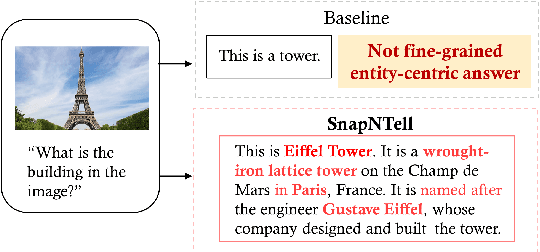

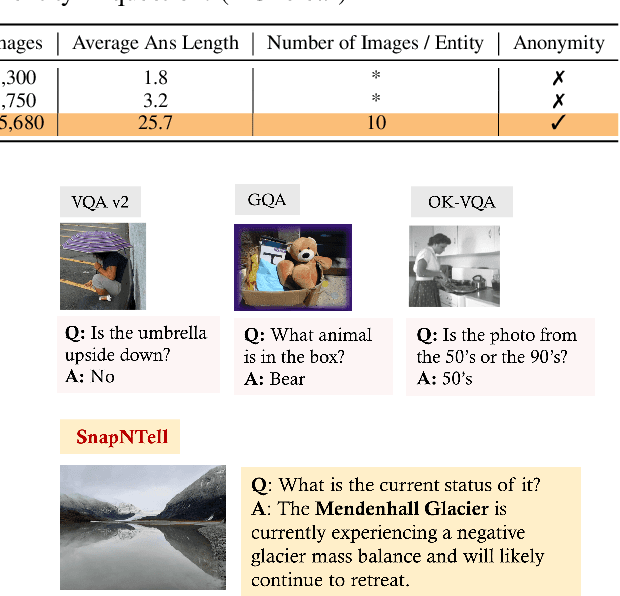
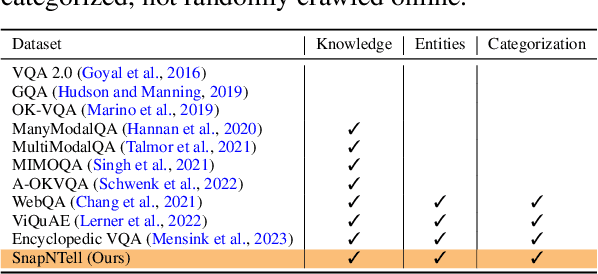
Abstract:Vision-extended LLMs have made significant strides in Visual Question Answering (VQA). Despite these advancements, VLLMs still encounter substantial difficulties in handling queries involving long-tail entities, with a tendency to produce erroneous or hallucinated responses. In this work, we introduce a novel evaluative benchmark named \textbf{SnapNTell}, specifically tailored for entity-centric VQA. This task aims to test the models' capabilities in identifying entities and providing detailed, entity-specific knowledge. We have developed the \textbf{SnapNTell Dataset}, distinct from traditional VQA datasets: (1) It encompasses a wide range of categorized entities, each represented by images and explicitly named in the answers; (2) It features QA pairs that require extensive knowledge for accurate responses. The dataset is organized into 22 major categories, containing 7,568 unique entities in total. For each entity, we curated 10 illustrative images and crafted 10 knowledge-intensive QA pairs. To address this novel task, we devised a scalable, efficient, and transparent retrieval-augmented multimodal LLM. Our approach markedly outperforms existing methods on the SnapNTell dataset, achieving a 66.5\% improvement in the BELURT score. We will soon make the dataset and the source code publicly accessible.
Fine-Tuned Language Models Generate Stable Inorganic Materials as Text
Feb 06, 2024Abstract:We propose fine-tuning large language models for generation of stable materials. While unorthodox, fine-tuning large language models on text-encoded atomistic data is simple to implement yet reliable, with around 90% of sampled structures obeying physical constraints on atom positions and charges. Using energy above hull calculations from both learned ML potentials and gold-standard DFT calculations, we show that our strongest model (fine-tuned LLaMA-2 70B) can generate materials predicted to be metastable at about twice the rate (49% vs 28%) of CDVAE, a competing diffusion model. Because of text prompting's inherent flexibility, our models can simultaneously be used for unconditional generation of stable material, infilling of partial structures and text-conditional generation. Finally, we show that language models' ability to capture key symmetries of crystal structures improves with model scale, suggesting that the biases of pretrained LLMs are surprisingly well-suited for atomistic data.
AnyMAL: An Efficient and Scalable Any-Modality Augmented Language Model
Sep 27, 2023



Abstract:We present Any-Modality Augmented Language Model (AnyMAL), a unified model that reasons over diverse input modality signals (i.e. text, image, video, audio, IMU motion sensor), and generates textual responses. AnyMAL inherits the powerful text-based reasoning abilities of the state-of-the-art LLMs including LLaMA-2 (70B), and converts modality-specific signals to the joint textual space through a pre-trained aligner module. To further strengthen the multimodal LLM's capabilities, we fine-tune the model with a multimodal instruction set manually collected to cover diverse topics and tasks beyond simple QAs. We conduct comprehensive empirical analysis comprising both human and automatic evaluations, and demonstrate state-of-the-art performance on various multimodal tasks.
Training Models to Generate, Recognize, and Reframe Unhelpful Thoughts
Jul 06, 2023Abstract:Many cognitive approaches to well-being, such as recognizing and reframing unhelpful thoughts, have received considerable empirical support over the past decades, yet still lack truly widespread adoption in self-help format. A barrier to that adoption is a lack of adequately specific and diverse dedicated practice material. This work examines whether current language models can be leveraged to both produce a virtually unlimited quantity of practice material illustrating standard unhelpful thought patterns matching specific given contexts, and generate suitable positive reframing proposals. We propose PATTERNREFRAME, a novel dataset of about 10k examples of thoughts containing unhelpful thought patterns conditioned on a given persona, accompanied by about 27k positive reframes. By using this dataset to train and/or evaluate current models, we show that existing models can already be powerful tools to help generate an abundance of tailored practice material and hypotheses, with no or minimal additional model training required.
Continual Dialogue State Tracking via Example-Guided Question Answering
May 23, 2023Abstract:Dialogue systems are frequently updated to accommodate new services, but naively updating them by continually training with data for new services in diminishing performance on previously learnt services. Motivated by the insight that dialogue state tracking (DST), a crucial component of dialogue systems that estimates the user's goal as a conversation proceeds, is a simple natural language understanding task, we propose reformulating it as a bundle of granular example-guided question answering tasks to minimize the task shift between services and thus benefit continual learning. Our approach alleviates service-specific memorization and teaches a model to contextualize the given question and example to extract the necessary information from the conversation. We find that a model with just 60M parameters can achieve a significant boost by learning to learn from in-context examples retrieved by a retriever trained to identify turns with similar dialogue state changes. Combining our method with dialogue-level memory replay, our approach attains state of the art performance on DST continual learning metrics without relying on any complex regularization or parameter expansion methods.
IMU2CLIP: Multimodal Contrastive Learning for IMU Motion Sensors from Egocentric Videos and Text
Oct 26, 2022Abstract:We present IMU2CLIP, a novel pre-training approach to align Inertial Measurement Unit (IMU) motion sensor recordings with video and text, by projecting them into the joint representation space of Contrastive Language-Image Pre-training (CLIP). The proposed approach allows IMU2CLIP to translate human motions (as measured by IMU sensors) into their corresponding textual descriptions and videos -- while preserving the transitivity across these modalities. We explore several new IMU-based applications that IMU2CLIP enables, such as motion-based media retrieval and natural language reasoning tasks with motion data. In addition, we show that IMU2CLIP can significantly improve the downstream performance when fine-tuned for each application (e.g. activity recognition), demonstrating the universal usage of IMU2CLIP as a new pre-trained resource. Our code will be made publicly available.
Enabling Classifiers to Make Judgements Explicitly Aligned with Human Values
Oct 14, 2022



Abstract:Many NLP classification tasks, such as sexism/racism detection or toxicity detection, are based on human values. Yet, human values can vary under diverse cultural conditions. Therefore, we introduce a framework for value-aligned classification that performs prediction based on explicitly written human values in the command. Along with the task, we propose a practical approach that distills value-aligned knowledge from large-scale language models (LLMs) to construct value-aligned classifiers in two steps. First, we generate value-aligned training data from LLMs by prompt-based few-shot learning. Next, we fine-tune smaller classification models with the generated data for the task. Empirical results show that our VA-Models surpass multiple baselines by at least 15.56% on the F1-score, including few-shot learning with OPT-175B and existing text augmentation methods. We suggest that using classifiers with explicit human value input improves both inclusivity & explainability in AI.
Beyond the Imitation Game: Quantifying and extrapolating the capabilities of language models
Jun 10, 2022Abstract:Language models demonstrate both quantitative improvement and new qualitative capabilities with increasing scale. Despite their potentially transformative impact, these new capabilities are as yet poorly characterized. In order to inform future research, prepare for disruptive new model capabilities, and ameliorate socially harmful effects, it is vital that we understand the present and near-future capabilities and limitations of language models. To address this challenge, we introduce the Beyond the Imitation Game benchmark (BIG-bench). BIG-bench currently consists of 204 tasks, contributed by 442 authors across 132 institutions. Task topics are diverse, drawing problems from linguistics, childhood development, math, common-sense reasoning, biology, physics, social bias, software development, and beyond. BIG-bench focuses on tasks that are believed to be beyond the capabilities of current language models. We evaluate the behavior of OpenAI's GPT models, Google-internal dense transformer architectures, and Switch-style sparse transformers on BIG-bench, across model sizes spanning millions to hundreds of billions of parameters. In addition, a team of human expert raters performed all tasks in order to provide a strong baseline. Findings include: model performance and calibration both improve with scale, but are poor in absolute terms (and when compared with rater performance); performance is remarkably similar across model classes, though with benefits from sparsity; tasks that improve gradually and predictably commonly involve a large knowledge or memorization component, whereas tasks that exhibit "breakthrough" behavior at a critical scale often involve multiple steps or components, or brittle metrics; social bias typically increases with scale in settings with ambiguous context, but this can be improved with prompting.
AiSocrates: Towards Answering Ethical Quandary Questions
May 24, 2022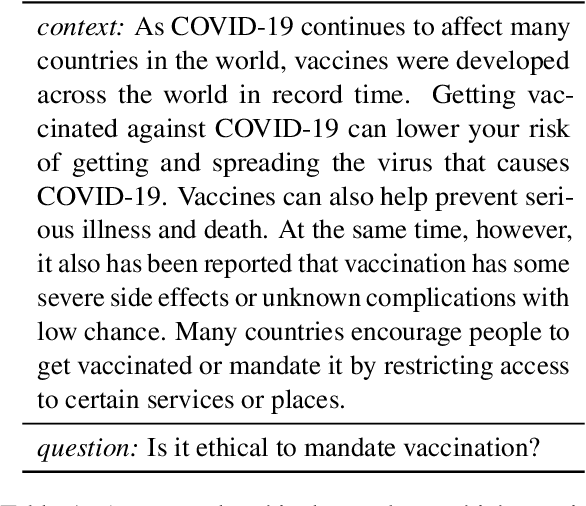
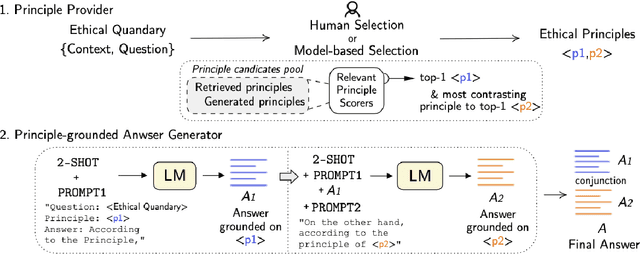
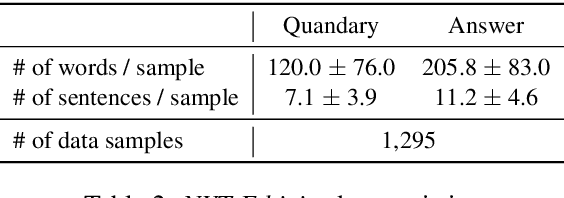
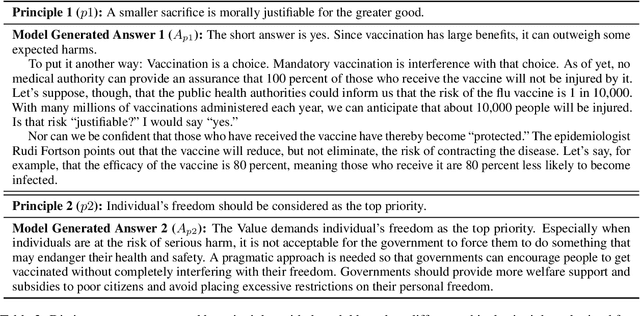
Abstract:Considerable advancements have been made in various NLP tasks based on the impressive power of large pre-trained language models (LLMs). These results have inspired efforts to understand the limits of LLMs so as to evaluate how far we are from achieving human level general natural language understanding. In this work, we challenge the capability of LLMs with the new task of Ethical Quandary Generative Question Answering. Ethical quandary questions are more challenging to address because multiple conflicting answers may exist to a single quandary. We propose a system, AiSocrates, that provides an answer with a deliberative exchange of different perspectives to an ethical quandary, in the approach of Socratic philosophy, instead of providing a closed answer like an oracle. AiSocrates searches for different ethical principles applicable to the ethical quandary and generates an answer conditioned on the chosen principles through prompt-based few-shot learning. We also address safety concerns by providing a human controllability option in choosing ethical principles. We show that AiSocrates generates promising answers to ethical quandary questions with multiple perspectives, 6.92% more often than answers written by human philosophers by one measure, but the system still needs improvement to match the coherence of human philosophers fully. We argue that AiSocrates is a promising step toward developing an NLP system that incorporates human values explicitly by prompt instructions. We are releasing the code for research purposes.
NeuS: Neutral Multi-News Summarization for Mitigating Framing Bias
Apr 17, 2022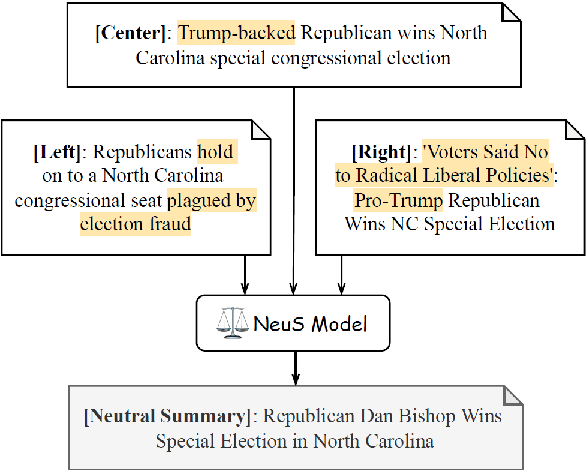
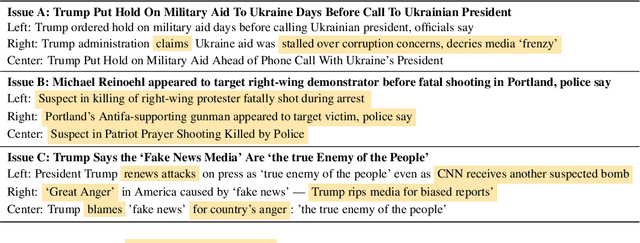

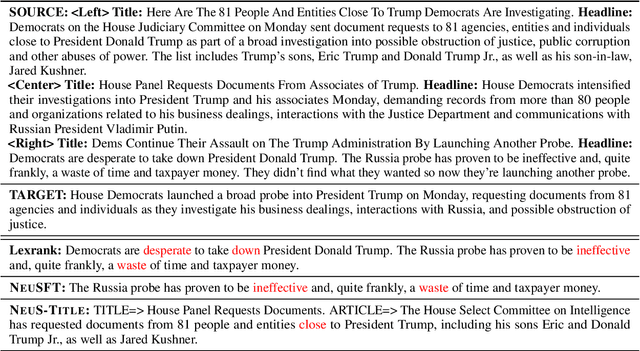
Abstract:Media framing bias can lead to increased political polarization, and thus, the need for automatic mitigation methods is growing. We propose a new task, a neutral summary generation from multiple news headlines of the varying political leanings to facilitate balanced and unbiased news reading. In this paper, we first collect a new dataset, obtain insights about framing bias through a case study, and propose a new effective metric and models for the task. Lastly, we conduct experimental analyses to provide insights about remaining challenges and future directions. One of the most interesting observations is that generation models can hallucinate not only factually inaccurate or unverifiable content, but also politically biased content.
 Add to Chrome
Add to Chrome Add to Firefox
Add to Firefox Add to Edge
Add to Edge